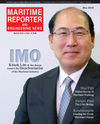
Page 15: of Maritime Reporter Magazine (May 2018)
Marine Propulsion Edition
Read this page in Pdf, Flash or Html5 edition of May 2018 Maritime Reporter Magazine
and the reality. to a certain aspect, intelligent stowage ogy, then we need to evolve, including train young people to become experts. If
While new technologies such as 3D- planning. our physical tools. However, while the we want to maintain or even push up the simulation, ? nite-element analysis and The engineering tools and method- equipment used is important, invest- standard we must be prepared to invest motion response analysis are slowly ologies used in shipping have remained ment in the right people is still the key to keep the industry interesting and at- working their way into the daily op- relatively the same for the last 15 years. to maximizing the value of a carrier’s tractive for young and brilliant people to erations of multipurpose shipping, un- If shipping is to keep step with technol- engineering capabilities. It takes time to join the industry.
derstanding of how these technologies contribute to the safe handling of project cargoes ? uctuates across the industry. In such cases engineering capacity can be lost in trying to implement these complex calculations, without comprehension of the bene? ts. Multipurpose shipping is already a highly specialized sector and new technologies must be thoroughly understood before their implementation disrupts the accepted standard. Continu- ing without this can result in additional costs and resources, and may also affect the safety of the operation.
On the other hand, as more general cargo carriers muscle in on the multipur- pose sector, we’re seeing the industry’s best practice methods become diluted.
Crews of general cargo carriers may not necessarily have the right knowledge and experience to safely transport the multi-billion-dollar cargoes common to the industry. For instance, some such crews and vessels might stick to the 1 m initial stability during the lift, as opposed to considering other relevant stability criteria, or confuse the requirements be- tween damage and intact stabilities.
The new IMO Resolution MSC.415(97) is an important milestone in heavy lift shipping. When it takes effect in Janu- ary 2020, for the ? rst time there will be international legislation setting stability criteria for lifting procedures, so it is important for crews transporting project cargoes to understand and adhere to best practice methods and calculations.
Emerging technologies
Exciting technological developments lie ahead. Just like autonomous cars are now being tested on our roads, the ? rst autonomous ship will be tested in 2019.
Today conventional ships with deck- house aft are limited when transport- ing tall cargo in case visibility from the command bridge is impaired. But the au- thorities must rethink. As long as safety standards are met, surely, they must ac- cept new technologies such as proximity sensors and infrared cameras to replace the naked eye.
There are other interesting technolo- gies, such as big data analytics, virtual reality, expert systems or arti? cial intel- ligence. All have hardly touched our in- dustry yet, but I am sure they will ? nd applications in the future, along with the already available 3-D simulation and, www.marinelink.com 15
MR #5 (10-17).indd 15 MR #5 (10-17).indd 15 5/3/2018 10:51:59 AM5/3/2018 10:51:59 AM

 14
14

 16
16
